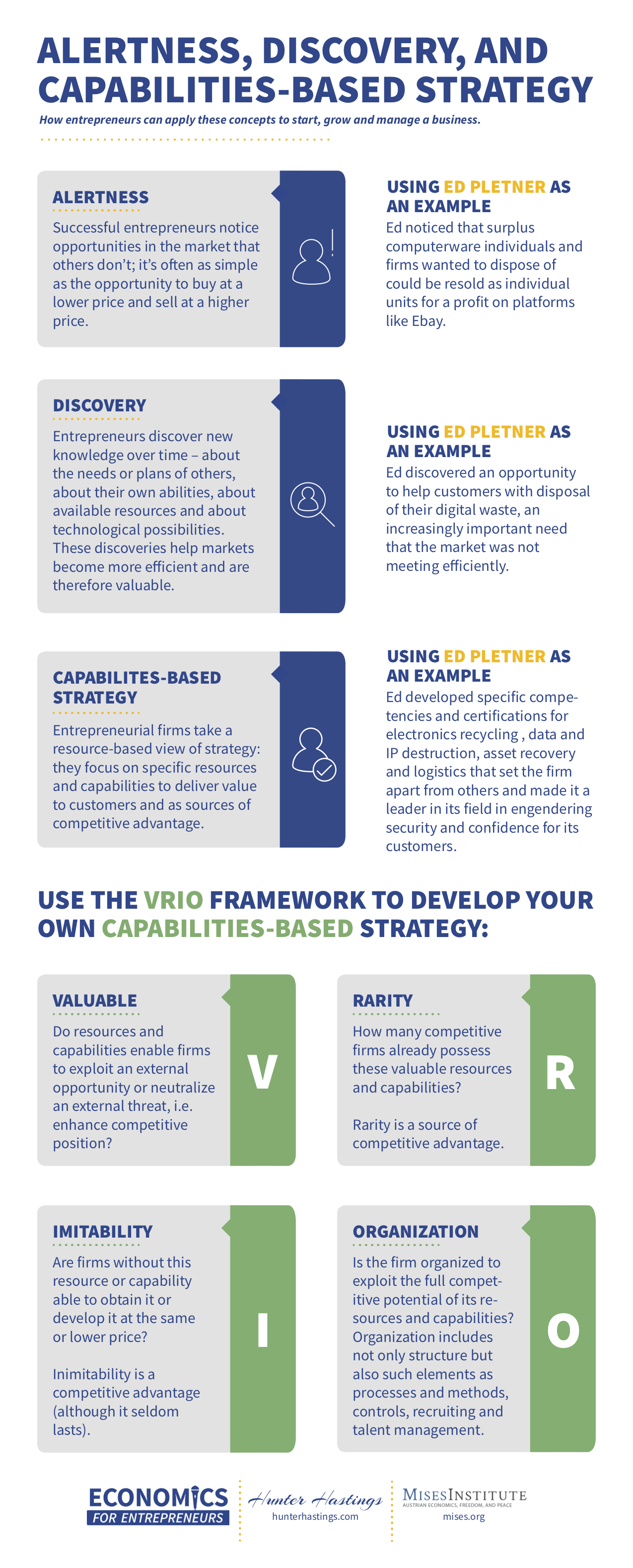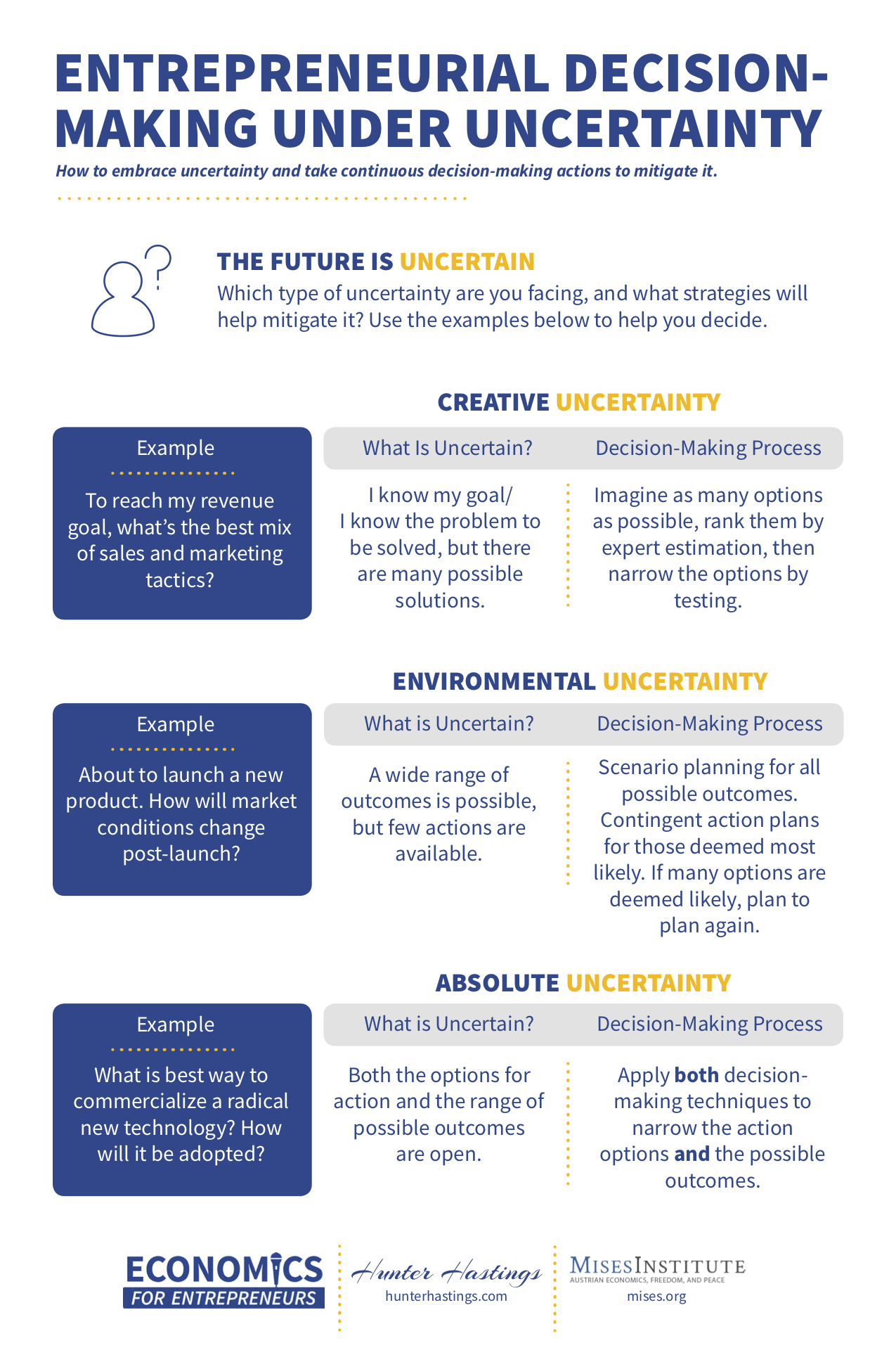10. Ed Pletner Applies Alertness, Discovery, and Capabilities-Based Strategy to Start, Manage, and Grow His Firm
Ed Pletner talks with Hunter Hastings about applying these economic concepts to start, grow, and manage a thriving and highly differentiated business.
Show Notes
Entrepreneurial theory in Austrian Economics employs several terms to describe the entrepreneurial process and the exercise of entrepreneurial skills.
- Alertness refers to the ability of some entrepreneurs to identify, and quickly gain profit from, marketplace opportunities to buy from one resource and sell to another in a way that benefits both and allows for a profit.
- Discovery refers to the process of applying empathic diagnosis to accurately identify unmet needs of potential customers and to rearrange resources to meet that need, enabling customer value and generating entrepreneurial profit.
- Capabilities-based strategy is the idea of identifying certain key resources — tangible or intangible — that enable a firm to establish a strong and potentially lasting competitive advantage in the marketplace. This approach to strategy is often packaged up in textbooks as the Resource Based View (RBV) of the firm.
Ed Pletner started his entrepreneurial journey with a straightforward application of alertness.
Ed began as an eBay “trading assistant”, buying from one source (individuals or businesses that had something to sell) and selling to other individuals who wanted to buy, and taking a commission on the trade. With effort, energy and hard work, Ed quickly established that he could sell to large audience and develop a revenue-generating business without the need for a large overhead or expensive technology.
As his trading business expanded, Ed discovered ways in which to serve many large customers with a new service of electronics recycling.
Ed began buying his own electronic equipment for resale from garage sales and local swap meets. He describes this as a “great experience” of discovering both sides of the service equation – who wants to sell and why; who wants to buy and why; and what are the specific conditions necessary to complete the trade.
It all started with buying and selling technology hardware. At the beginning, Ed was moving it from garage to garage — a seller’s garage to his own, in order to store it before reselling it. Then the business became engaged with bigger quantities — warehouse to warehouse.
He couldn’t sell everything — some items had to be recycled or destroyed. It was at this point that the discovery process yielded the business opportunity of data destruction and electronics recycling.
From dynamic marketplace change, there emerged the customer need for secure and compliant data destruction as an integral element of electronics recycling. The problem to be solved was called E-waste.
We always encourage entrepreneurs to find a problem that customers want solved. Ed discovered e-waste. When hardware is recycled, there is always an associated amount of data: customer records, company data, financial records, health records, memos, emails etc., on hard drives, thumb drives, and all kinds of digital media. It has to be destroyed. And the customer needs to feel confident and assured that there is no failure or leakage in the destruction process, and that they can prove to regulators or auditors that they did the right thing and hired the right experts to avert any potential issues or claims.
Ed was able quickly to recognize the opportunity to become a trusted service provider in data destruction.
Ed invested in capabilities to enhance and strengthen his credentials in this emerging market that had a strong need for standards.
Ed understands subjective value. Value is, as he puts it, “in the eyes of the beholder”. And in this case, the beholders were the clients who had stringent guidelines to follow — HIPAA guidelines, or financial industry guidelines or contractual customer requirements — regarding how data is destroyed. It was most important to these clients to be able to retain a service that is compliant — that can provide proper certification of destruction and a third party audit. They are looking to avoid both legal and financial penalties and any reputational risk.
Ed invested in establishing his company, avritek, as a properly certified vendor. R2 Responsible Recycling is the industry environmental standard for electronics recycling. ISO 14001 and OHSAS 18001 are environmental and worker safety and health certifications. NAID (National Association of Information Destruction) is a location-based certification with onsite auditing for both paper and digital data destruction standards. Avritek has them all.
Ed has embraced the capabilities-based strategy approach wholeheartedly, always asking how he can expand his capabilities to serve clients better. How do we install a larger shredder to better serve large scale clients? Which ERP system shall we install to tie in all our processes and partner services? This is a lot different than spreadsheet based planning and budgeting. It’s all about delivering more value to clients via better capabilities.
Customer segmentation follows from commitment to capabilities. Avritek does not have to target customers. It aligns with them and synchronizes with them by understanding what they care about and providing the capabilities to enable them to exercise that care. In San Diego, where avritek is based, there are many biotech firms. They care deeply about data security, not only for compliance reasons but also because “they are in a caring industry”, as Ed puts it.
Interconnectivity opens up an international business footprint for the capable, service-oriented firm. Avritek is San Diego based. Many of its clients have offices and locations in multiple states and multiple countries. By partnering with similarly-credentialed electronics recycling companies, Avritek can provide a complete service to clients, along with a single point of invoicing, administration and relationship management. In this way, capabilities-based strategy is an excellent route to organic growth with high levels of capital efficiency.
DOWNLOAD
Download Alertness, Discovery and Capabilites-Based Strategy.pdf (71.83 KB)

